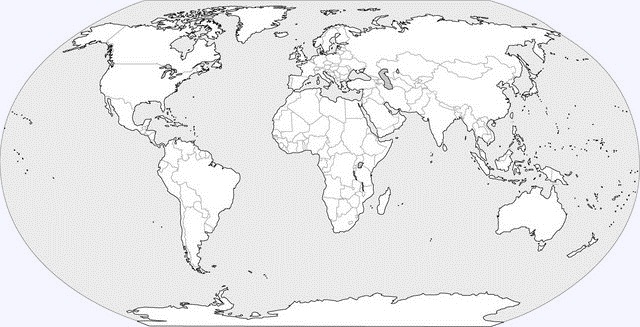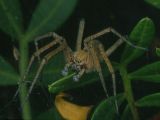|
Nombre común en ingles:
Palp-footed spiders
Nombre común en castellano:
Se desconoce
Familias similares:
Género tipo:
Palpimanus Dufour, 1820
Diagnosis:
Small to medium-sized araneomorph
spiders; two or three tarsal claws; ecribellate; entelegyne (with
secondary haplogyny); six or eight-eyes; first pair of legs enlarged
and stronger than other pairs and with prolateral scopula on distal
segments; carapace heavily sclerotized; reduced number of
spinnerets.
Caracteres descriptivos:
Caparazón:
suboval in outline or anteriorly truncated; cephalic region evenly
rounded sloping gently towards thoracic recigon; fovea usually
distinct; covered with a hard, coriaceous gramular epidermis. Esternón:
scutiform, as wide as long; strongly granular; with extensions
around coxae. Ojos: usually eight; sometimes six; if eight,
eyes in two rows, position varies between genera; lateral eyes
either contiguous or widely separated; posterior median eyes small
or large and irregular in shape. Quelíceros: short and stout;
cheliceral furrow weakly developed; true teeth may be present on
retromargin but never numerous; promargin with peg teeth opposite
tip of fang, which is short and stout. Piezas bucales: labium
triangular; endites converging and almost touching: serrula strong. Patas:
two or three tarsal claws; anterior pair of legs enlarged and much
stronger than other three pairs with femur I greatly expanded
dorsally; patellae elongated; metatarsi and tarsi reduced in size;
thick scopula with spatulate setae distally on prolateral surface of
tibia, metatarsi and tarsi; tarsal claws dissimilar in size,
anterior tarsi with extremely small claws, larger on posterior legs
and directed upwards. Palpo femenino:
without claw; tarsi with thick setae forming a brush. Abdomen:
ovate; cuticle of abdomen often coriaceous with epigastric region
heavily screrotized, forming a ring-shaped scutum extending dorsally
to encircle pedicel (Palpimaninae); scutum absent in Chediminae;
abdomen with sparse cover of short setae. Hileras:
encircled by sclerotized ring; anterior pair large with piriform
gland spigots in a linear arrangement; posterior lateral and median
pairs reduced to spigots in females, absent in males; colulus
absent. Sistema respiratorio:
two booklungs; single tracheal spiracle near spinnerets. Genitalia: entelegyne
(secondary haplogyne); internal structure simple; in some cases
consisting of two large membranous sacs opening into a common atrium
with large secretory glands near base; spermathecae small, laterally
connected to atriom by long duct; male palp bears, in addition to
embolus. an elaborate conductor and often other terminal accesory
sclerites; tibia frequently bulbous. Tamaño corporal:
3-11 mm. Color: carapace often dark to bringht red or bright
orange; abdomen fawn, grey to purplish, sometimes with large spots;
legs similar in colour to carapace.
Estatus taxonómico:
The Palpimanidae are placed with eight other families in the
Palpimanoidea, with either the Huttonidae (Coddington & Levi, 1991)
or the Stenochilidae (Coddington et al., 2004) as sister-group.
Distribución: Throughout
most of the tropical and subtropical regions of the world excluding
Australia.

Estilo de vida:
Palpimanids are free-living ground dwellers, which appear to have a
specialized diet consisting of spiders.
Bibliografía:
-
Dippenaar-Schoeman, A.S. & Jocqué,
R. 1997. African Spiders: An Identification Manual. Plant Protection
Res. Inst. Handbook, no. 9, Pretoria, 392 pp.
-
Platnick, N.I.,
Coddington, J.A., Forster, R.R. & Griswold, C.E. 1991. Spinneret
morphology and the phylogeny of Haplogyne spiders (Araneae,
Araneomorphae). Am. Mus. Novit. 3016: 1-73 .
-
Platnick, N.I.,
Grismado, C.J. & Ramírez, M.J. 1999. On the genera of the spider
subfamily Otiothopinae (Araneae, Palpimanidae). Am. Mus. Novit.
3257: 1-25.
1 género y 1 especie presentes en la Península Ibérica:
|
| |
- P. gibbulus
Dufour, 1820 |
| |
|
 |